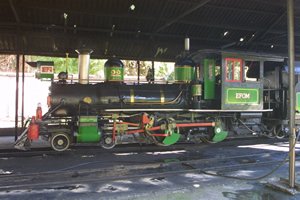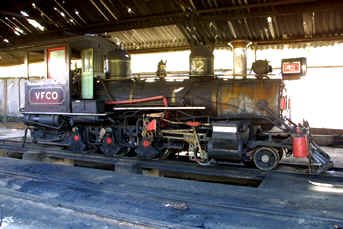|
History preserved in São João del Rei |
 |
|
The train for Tiradentes is still a popular success |
|
Since September 2001, the Ferrovia Centro-Atlântica (FCA) has taken over management of the railroad complex at São João del Rei, Minas Gerais. The concession was granted by the Transportation Ministry on a temporary basis for a one-year period, until the National Land Transportation Agency was able to effectively regulate the sector. Under new administration, the museum was reopened, and the passenger train |

|
|
The 4-4-0 Baldwin, from 1908, is completely original, except for the track sweep |
|
between São João del Rei and Tiradentes, which operated with only two locomotives, began to use four steam engines for the stretch. The São João del Rei railroad complex, protected as a Heritage Site by the National Artistic and Historic Heritage Institute (IPHAN), contains the largest collection of preserved and original steam engines from a single manufacturer - Baldwin - and a single railroad - the Estrada de Ferro Oeste de Minas (EFOM). At this location there are some 15 Baldwin locomotives specially built for a Baldwin 0.76 m gauge track, of which only one has been stripped for parts. Six are in operating condition - two using firewood and four running on oil. The other eight locomotives are complete, but halted - seven in the rotunda, built in 1882, and one in a museum at the train station. The complex also shelters another three metric-gauge locomotives that used to work for the old Rede Sul Mineira: two Baldwins - one of them cut in half for demonstration purposes - and a German-made Schwartzkopff, as well as a number of wooden cars and even a funeral carriage, containing an urn for carrying coffins. |
|
|
At the end of the 1980s, the, São João Del Rei complex received the visit of descendents of the Baldwin family. According to a report prepared by the railroad, the members of the Baldwin clan - which once was the U.S.'s largest manufacturer of locomotives before the diesel-electric engines were introduced, - had never previously seen a preserved group of so many of its engines. |
| Maintaining a Baldwin 4-6-0 (1912) that pulls the Tiradentes train |
|
And what was it that saved these locomotives in a country that cut up and sold off the majority of its steam engines for scrap metal when they were substituted by the diesel-electrics? The fact that the Estrada de Ferro Oeste de Minas engines ran on a smaller gauge track meant they could not be shipped off to other railroads, all of which were metric gauge or larger (1,60m). And because diesel manufacturers did not build engines for a 0.76 m track, bitola de 0,76 m, |
 |
| The only scrapped engine is this 2-8-0, from 1893 |

|
the EFOM continued to operate its steam engines. In all of Brazil, diesel substituted steam on the railroads during the 1950s and 1960s, but on the EFOM the steam engines continued to operate until the 1980s. They at one point hauled 11cement trains per day between the Barroso factory and Aureliano Mourão, in Lavras, where the freight was loaded aboard a metric-gauge train to continue the trip to Maringá, in Paraná. |
|
Seven non-operational Baldwins are kept inside the rotunda |
|
The final destination was the Itaipu Dam construction site in Foz do Iguaçu, 420 kms distant. Considered one of the largest construction projects of the 20th century, Itaipu Dam required so much raw materials that suppliers from all regions of the country were used, using the railroads to bring the merchandise from the more distant locations. |
 |
| The rotunda at São João Del Rei, with a Baldwin 4-4-0, dating from 1912. |
|
|
At the peak of construction of the dam, between 1975 and 1984 – some 350 trucks a day left the offloading yard at Maringá for Foz do Iguaçu carrying cement, steel and other products, according to the institutional book “Itaipu, a Luz”. After this, the majority of the São João Del Rei locomotives were retired from service, but sightseeing train to Tiradentes never ceased to operate. |
| The Tiradentes locomotive turntable. |
|
Today, the boilers are fueled by oil instead of firewood to produce steam. On weekends and holidays six trains a day operate along the 12-km line — wehat is left of a railroad that once had 729 kms of track. The price of the roundtrip São João Del Rei-Tiradentes ticket (R$ 14.00, adults, and R$ 7.00, children) and of space for events is sufficient to maintain the complex, according to the FCA. However, the company has plans to recuperate facilities through partnerships with other companies. |
|
| The train and locomotive in position to make the return trip to S. João del Rei | |
|
|


